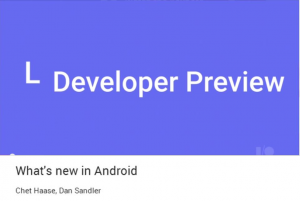For developers, it’s always worth thumbing-through major announcements, trends and more especially, the particular media feedback generated from those big Stateside developer conferences; namely Apple’s WWDC and Google’s IO — which has just been held at the iconic Moscone West Convention Center in San Francisco (June 25–26).
That said, sometimes the signal-to-noise ratio can get out of sync, but in this case all the hubbub that went before at the Apple WWDC event (at the self-same venue only week’s earlier), ergo, the new versions of the OSX and iOS operating systems, plus announcing OS X Yosemite and iOS 8. As well as Apple releasing Swift, a new Apple programming language that looks to “keep developers with Apple” — almost immediately got drowned out by the sheer volume of announcements let loose by a reinvigorated collective of geeks, led in this case by Android head Sundar Pichai.
Media-wise, leading publication The Verge, summarized things with great alacrity in its considered piece, The 17 most important things Google announced at I/O”:
“He (Sundar Pichai) started the keynote with some impressive stats: 1 billion active users, 20 billion texts and 93 million selfies a day. But that only covers a fraction of the world’s population, and Google is ramping up its efforts to reach people who so far haven’t been able to afford a smartphone.”
Of special interest though, is the much-vaunted projected launch of “a new version of Android, codenamed ‘L’ that won’t arrive until later this year”. This actually sparked a humorous thread or two, debating potential reasons for the specific name, especially for those with a sweet tooth, but probably the most interesting – was that L leveraged its own Roman numeral status (the number 50) to stand for 5.0?
From the Minimob point of view, all improvements and enhancements are warmly welcomed as Google continues to drive the massive adoption of Android Apps (for its soon to be launched $100 smartphones with partners like Karbonn in India among others) and is building a formidable ecosystem of revenue generating options for global-gazing developers who can now envisage expeditiously accessing the “next billion” mobile consumers.
More specifically for Minimobbers, as related by Wired: “L also streamlines the notifications process. You get instant access to notifications from the lock screen, so that you can act on them without unlocking the phone. The most important ones rise to the top, but you can also swipe down on them to expand them. There’s a heads-up notifications feature now, too, that allows you see a notification and act on it from within an app without stopping what you’re doing.”
So Google, we hear you loud-and-clear, the “power of push” has been regularly discussed on this blog; and (whilst following best practice at all times) the improved capabilities offered in Android L (5.0) should lead to the rapid maturation of push notification communication strategies that significantly and positively impact user behaviour and engagement.





